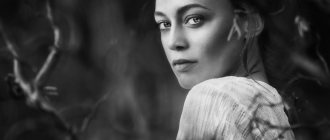First, let's define what a psychological portrait of a person is. A psychological portrait of a personality is a description of the inner world of an individual. Personality type, temperament, character, interests, abilities and much more are considered. Describing the psychological characteristics of a person is a complex process that involves several stages. Each of them has its own nuances and meaning, none of them should be missed. Let's figure out how and why you can create a psychological (socio-psychological) portrait of a personality.
Why do you need a psychological portrait of a personality?
Personality analysis helps in the work of a psychologist, social educator, psychiatrist, criminologist, and teacher. With its help, you can find an approach to any person, predict his reactions and actions, and select the optimal plan for rehabilitation or other work with the individual.
In addition, a psychological portrait is drawn up during the selection of personnel in marriage agencies. The ability to analyze the components of a portrait is useful in business for analyzing customers, partners, and clients. Personality studies are also used in career guidance.
In the end, the picture being compiled will be useful to anyone who wants to easily find mutual understanding with people. Based on your portrait, you can improve your relationships with your loved ones. Identifying and learning your psychological portrait is useful for self-development.
Is it possible to make up by appearance?
Some people are confident that psychologists, by looking at a person, can create a complete portrait of a person. Actually this is not true. You can't judge by appearance alone, especially when it comes to photography.
However, there are areas that do just that:
- physiognomy – the science of the connection between psychological and anatomical characteristics of a person;
- Kinesics is a science that studies non-verbal communication (gestures, facial expressions, body position, movements, etc.).
And yet, to paint a portrait, it is better to pay attention to the study of the inner world, and not to the appearance. Some researchers still consider physiognomy a pseudoscience.
Compilation example
A psychological portrait, regardless of its purpose, is drawn up by a specialist. The psychologist determines the appropriate methodology in accordance with the purpose of the test. For independent analysis, you can use simplified methods. Socionics and DISC research are suitable, for example. Such tests can be taken online - they are available on the Internet.
What does a finished psychological portrait look like? An example is presented below. His conclusion is based on the results of tests by Eysenck, Mehrabian, and Cattell:
Elena Nikiforova, student, 20 years old; character traits: sociability, friendliness, impulsiveness, good nature, tendency to aggression, actions under the influence of emotions, emotionality; temperament (Eysenck test): sanguine, easy to communicate, make friends, good ability to adapt; intellectual qualities (Cattell test): quick perception of information, abstract thinking; motivation (Mehrabian test): achieving the intended goal; emotionality: average stability, irritability, excitability, stubbornness; sociable qualities: sociability, independence, activity, desire for leadership, good adaptive abilities; conclusions: the results of the study are within normal limits, it is recommended to pay attention to increased suspicion.
After a detailed consideration of what a psychological portrait is, its role in the modern world becomes clear. It is used in many areas of human life: in the professional, social, and personal spheres. The psychological characteristics of an individual are an important factor in choosing a life path and career path.
Components of a psychological portrait of a personality
Let's look at how to create a psychological portrait of a person. There are various modifications of the portrait, but most often its structure includes the following elements:
- human temperament (type of nervous system);
- IQ and predisposition to intellectual work;
- leading character traits;
- personality orientation;
- level of self-esteem;
- capabilities;
- values;
- communication skills;
- emotional-volitional sphere;
- motivational sphere;
- individualism-collectivism;
- other.
During diagnosis, it is important to maintain objectivity, clearly distinguish between facts and speculation, and exclude personal attitudes towards the person being examined. Therefore, it is better to entrust this to a professional psychologist. However, in the course of diagnosis, he also uses different methods: observation, tests and questionnaires, conversations with the subject’s friends, etc.
Each specialist has his own arsenal of tools. In addition, the set of diagnostic techniques depends on the specific case. Universal tests are always used, for example, to determine the temperament and orientation of a person, and methods of a narrower spectrum are selected individually. For example, in one case it is important to assess a person’s motivation (type and level), in another case - the level of anxiety or neuroticism, in a third - the severity of leadership qualities, etc.
In addition, it is important to consider the age of the subject. For example, to determine the psychological portrait of a child’s personality, it is better to choose projective tests: “Non-existent animal”, “House, person, tree”, “Unfinished sentences”.
Important! It is recommended to draw up a psychological portrait professionally, that is, trust a psychologist.
How to recognize a phlegmatic person
Functions of communication in psychology and their brief description
A phlegmatic person is a person who has the following characteristics:
- He is characterized by calmness, at times he is the standard of tranquility;
- He knows how to smooth out conflicts, not support an aggressive argument, and is generally good-natured;
- Does not give in to provocations, is reasonable, knows how to analyze the situation and evaluate it;
- Speech is quiet, calm, smooth;
- Gestures are minimal, as are facial expressions;
- Knows a sense of proportion in everything that concerns himself;
- Not spoiled, unpretentious, adapts to places and people quite quickly.
It is noteworthy that, having such a calm temperament, his representative is not at all boring or indifferent, as it might seem. This is one of those representatives of people who first listen, observe, and adapt. Having gained the trust of such an individual, you can acquire a wonderful friend, partner and colleague for many years.
There is an opinion that this type of people, due to their inertia, is prone to fullness and roundness of shape. Among the crowd, they are distinguished by their smooth gait, slowness in movements and speech. However, this is not always an indicator.
People with this temperament hold back their emotions
How to make a psychological portrait of a personality
To draw up a portrait, you need to ask a person to undergo several tests. However, this is not the only way. Let's consider popular methods and algorithms for drawing up a psychological portrait.
Eysenck test for determining temperament
The subject is asked to answer 57 questions. Based on the results of the survey, a graph is drawn up that shows the share of each type of temperament (not a single type is found in its pure form).
The test reveals not only the type of temperament (sanguine, choleric, phlegmatic, melancholic), but also the orientation of the personality: extroversion, introversion, ambiversion. The test also shows the client’s emotional stability or instability.
Eysenck IQ test
It determines not only intellectual development, but also creativity and the ability to think logically. The subject is asked to solve several problems. Then the results are summed up. The average IQ is 100-120 points. A score above 150 indicates genius, less than 80 indicates retardation.
Cattell's 16 factor questionnaire
The subject is asked to answer 187 questions. The technique allows you to assess several important psychological characteristics at once:
- isolation - sociability;
- concrete – abstract thinking;
- emotional stability – instability;
- the habit of submission is the habit of dominating;
- restraint - expressiveness;
- adherence to norms and discipline – low normative behavior;
- timidity - courage;
- realism - sensuality;
- suspicion - gullibility;
- practicality - dreaminess;
- naivety - insight;
- calm – anxiety;
- conservatism - radicalism;
- conformism - nonconformism;
- weak self-control – high self-control;
- relaxation – emotional tension.
Based on this alone, it is possible to create a detailed portrait of a personality. And if you also evaluate paired combinations of indicators, you can find out the following:
- leadership potential;
- communication skills and need for communication;
- attitude towards other people;
- intelligence;
- flexibility and speed of mind;
- emotional sensitivity;
- risk appetite;
- level of self-discipline and adherence to morality.
If you conduct this test in full, consider all the interpretations, then you can only use this technique alone to create a full-fledged portrait of a person. For example, this will be quite enough for personnel selection.
Eysenck test “Self-assessment of mental states”
The technique allows you to identify and assess the severity of anxiety, frustration, aggressiveness, and rigidity. It is noteworthy that the survey results describe the client’s subjective feeling. This test is often used by psychologists and psychiatrists.
Self-assessment of stress resistance (N.V. Kirsheva, N.V. Ryabchikova)
The subject is asked to answer 18 questions. Based on the survey results, you can determine the level of stress resistance: from very low to very high. The test results will be useful when choosing a profession and job, selecting personnel, and in consultations with a psychologist. This questionnaire is also suitable for self-diagnosis and work on self-regulation and your emotions.
Test S.V. Kovalev on self-esteem
The subject is asked to answer 32 questions. Based on the survey results, you can determine the type of self-esteem: adequate high, adequate average, inadequate low. Unfortunately, the test does not detect inadequate high self-esteem.
PIK methodology (indicators of individualism - collectivism, author L. G. Pochebut)
The subject is asked to answer 30 questions, or rather, choose one of the statements in 30 groups. The answers are compared with the key, and one point is awarded for each match. Then the overall score is determined and the orientation of the subject’s personality is revealed: individualism or collectivism.
“Hierarchy of needs” as modified by I.A. Akindinova
Knowing the needs of an individual can tell a lot about priorities, values, beliefs and interests. The subject is asked to complete the phrase “I want...” and is given 15 options for continuation. You need to arrange them all in descending order of importance. The test allows you to identify the dominant need and determine the degree of satisfaction of the following needs:
- material goods,
- safety,
- interpersonal connections,
- respect from other people,
- self-realization.
The hierarchy of needs helps to understand the motivation for a particular person’s actions.
“Motivation for success and fear of failure” (FUN) questionnaire by A.A. Reana
The subject is asked to answer 20 questions, the answers are compared with the key. The total score indicates the type of motivation: fear of failure, hope of success, or a neutral indicator. The interpretation of the results describes not only the type of motivation, but also related personality traits and characteristic patterns of behavior.
Social Network Analysis
A modern method of writing a social portrait of a person. Specially trained psychologists analyze records, groups, photographs, music, videos, friends list and other data from a particular person’s page. A specialist can even distinguish true information from false information, and separate the desired image (which a person is trying to show online) from the real one. This method is often used in forensic science.
Conversation with relatives and friends
A universal method that complements any tests. It is especially often used when diagnosing a child or when working with couples, families, and groups.
Study of activity products
The method allows you to determine interests and abilities, knowledge and skills, values, priorities and much more. This method is suitable for remote diagnostics. Drawings, essays, crafts, reports, etc. are used for research. Anything that the person being examined himself did (filled out, wrote, drew, etc.) will do. This method is often used to compile a psychological portrait of famous and famous people, especially those who have already died.
The face is a social tool
Researchers have proven that the human brain recognizes the face as a whole, and not in the aggregate of individual parts of an individual’s face. Peter Thompson demonstrated this with a photograph of Margaret Thatcher. An upside-down photo, but with unchanged eyes and lips, at first glance, was not noticed by anyone.
The face is an informative, adaptive, social tool about a person’s psychotype and character, even about his behavioral stereotypes.
A portrait of a personality is read on an unconscious intuitive level. We have a certain experience of socialization, and even in childhood, school and in other institutions we have learned to expect identical actions and behavior from people with similar traits.
An example of writing a psychological portrait of a personality: sample
Let's look at ready-made psychological personality portraits, examples and writing samples.
Example No. 1
Client Ivan Ivanov (35 years old) has the following psychological characteristics:
- Temperament: sanguine.
- IQ: average level.
- Leading character traits: persistence, a heightened sense of duty and justice.
- Communication skills: well developed. Knows how to find a common language with different people, gain trust and negotiate.
- Abilities: noticeable leadership inclinations.
- Personality orientation: extraversion.
- Self-esteem: adequate, high.
The tests themselves and the results of intermediate studies are not included. Sometimes the gender, date of birth and education of the person is indicated, but this is not necessary. If the portrait is drawn up by a psychiatrist, he can briefly describe the patient’s life history, recent shocks and traumas. When drawing up a psychological portrait of a student, the teacher can write down brief information about the family.
Interesting! There is no single ready-made sample, so most often the portrait is described in free form (unless the company where the diagnostician works specifies otherwise).
Example No. 2
There are also other design options. For example, this is what a detailed psychological portrait of a person looks like: Subject: Vasily Vasechkin.
Gender: male.
Age: 20 years old.
Education: student, studying to become a lawyer.
Methods used: Eysenck questionnaire (for temperament), Cattell test (16 personality factors), stress resistance test, motivation test (achieving success or avoiding failure).
During the diagnosis, it was revealed that the client has pronounced leadership potential, but at the same time is sometimes afraid of failures and is characterized by increased anxiety. These features distort the typical portrait of a choleric person (this temperament was identified in the subject). Anxiety is contradictorily combined with determination, and a high level of responsibility and a developed sense of duty balance the motivation to avoid failure.
Conclusion and recommendations: in general, a harmonious personality type, but due to low resistance to stress and high anxiety, problems may arise in the professional field (law). Perhaps it is worth choosing a different profession or working on developing weak qualities.
Important! In general, the algorithm for drawing up a psychological portrait is as follows: brief information about the client, a description of the elements of the portrait, a general conclusion and recommendations.
Definition
A psychological portrait is a detailed description of a person’s personal characteristics. It takes into account both the innate characteristics of the nervous system and the traits acquired during life. A psychological portrait allows one to predict with high accuracy a person’s behavior, his reactions to various situations and stimuli.
To compile a psychological portrait, various diagnostic techniques are used: tests, questionnaires, experiments, interviews.
More than 100 cool lessons, tests and exercises for brain development
Start developing
The human psyche is a very complex mechanism. It consists of many components that are intertwined. From their interweaving, a personality pattern is formed, unique and inimitable, like a fingerprint.
The internal structure of the psyche mediates external behavior and explains why in specific situations a person acts one way and not another.
Knowing a person for many years, we can predict his behavior quite accurately. But what if you need to obtain data quickly and there is no time or opportunity to communicate with a person for a long time? In this case, a psychological portrait comes to the rescue.
Questions to determine your psychological portrait
There are no specific questions. To find out and write your psychological portrait of a personality, it is better to use simple techniques, for example, geometric and projective tests.
One of the popular techniques is the S. Dellinger test. To describe yourself, ask just one question: “Which shape attracts me more: rectangle, square, circle, triangle or zigzag?”
The interpretation of the answer helps determine the personality type:
| Figure | Description of the psychological portrait |
| Triangle | You are a born leader, accustomed to concentrating on the main thing. You easily manage to process large amounts of information and find a common language with different people. However, excessive rationality sometimes interferes with interpersonal interaction. |
| Rectangle | You are constantly in a state of search, thirsting for change. So from time to time you turn into one of the other types. Rectangle is the most unstable personality type. |
| Square | You are not afraid of work and are used to always achieving your goal and finishing what you start. You can achieve success in any field, but it is better to give preference to intellectual work. A measured life and the same type of work are more suitable for you; you love rules and order. |
| Zigzag | The most creative type. Because you think outside the box, you can be impulsive and inconsistent, which sometimes alienates others. However, at the same time, you know how to win over people. |
| Circle | The most harmonious type. The main value for you is interpersonal relationships. You are a born psychologist and diplomat. |
Socionics test: 16 personality types
Surprisingly, there are only 4 pairs of traits - 8 from C. Jung’s personality typology and 2 from information psychology - and we end up with 16 personality types, each of which is unique and has the name of a real historical or literary type.
Don Quixote, Dumas, Hugo, Robespierre, Napoleon, Balzac, Jack London, Dreiser, Hamlet, Maxim Gorky, Zhukov, Yesenin, Stirlitz, Dostoevsky, Huxley, Gabin.
Do you want to know who you are? Then read the characteristics of 4 pairs of personality traits and select 1 characteristic in each pair. 4 characteristics will give you the desired psychological portrait of your personality out of the 16 indicated.
Basic criteria for compiling a psychological profile
Before drawing up a psychological portrait of a person, it is advisable to familiarize yourself with its components. Due to the uniqueness of each personality, basic and guiding qualities are inherent. Main components include:
- temperament;
- character;
- personal properties.
Guide components include:
- self-awareness;
- intelligence;
- direction.
According to their sensitivity, representatives of society are classified into several categories:
- Orientation for today. The person easily gets used to the role and adapts well. He is characterized by quick decision making. A leadership position is suitable for such a person.
- Focus on the past. A person acts in accordance with accepted rules and laws. Performs well in executive positions.
- Future-oriented. It is difficult for a person to join a team and does not recognize hierarchy. But such people often put forward progressive ideas. Independent work (“your own boss”) is suitable for them.
In addition to the criteria considered, before drawing up a psychological portrait of a person, it is necessary to determine the following personality traits.
Temperament
Its basis is the specific characteristics of the nervous system. The behavioral model of an individual depends on temperament; it is difficult to correct. There are 4 known types of it, which are used by a psychological portrait of a personality:
| Temperament type | Characteristics |
| Choleric | Mood instability, emotionality, craving for novelty |
| Sanguine | Balance, rational behavior |
| Melancholic | Unstable psyche, pessimism |
| Phlegmatic person | Enviable poise, shyness |
Character
These are distinctive human qualities. They are used in communication and social activities. Character is determined by a set of characteristics, including attitude to a number of life aspects, such as:
- Job;
- environment;
- the man himself;
- material values.
Capabilities
These are specific human qualities. Abilities presuppose achieving success in a certain activity or area of life. These properties can be developed through training and practice.
Focus
The basis of purposefulness is incentive, motivation. The behavioral model of the individual and his activity depend on this property. While one person longs to satisfy his own needs and create the desired conditions for his life, another finds himself in the social sphere, volunteering, and embodies creative abilities.
Emotionality
This property does not depend on a person’s desire, it is not subject to his will. Emotionality is a response to external stimuli
It shows the importance of a certain event for him. Personal strength is determined by the ability to manage emotions, keep them under control, and not show feelings
Intelligence
This is an indicator of a person's education. The level of intelligence is predetermined by education, current activity, and age. He is involved in decision making, assessing situations, controlling behavior, adaptability, and creating relationships with the environment. Rationality of thinking and acting in accordance with the situation depends on intelligence.
Sociability
According to psychology, a ready-made psychological portrait of a person includes an assessment of sociability - an important distinctive character trait that reveals individual qualities. When communicating, not only information is transmitted, but also thoughts, feelings, knowledge
Self-esteem
Self-analysis contributes to the development of the individual’s position towards himself. Through self-analysis, individual sensitivity, place in society, and achievements are assessed.
Volitional properties
Character traits revealed when creating a psychological portrait of an individual predetermine actions and directly affect a person’s life course. A strong-willed character is characterized by the ability to make independent decisions and overcome life’s difficulties; it is characterized by perseverance, perseverance, and determination. For people with a weak will, weak character is typical. Despite having the qualities necessary to achieve success, they rarely become successful.
Self-control
Self-control affects the ability to behave appropriately in society and good manners. A person who does not control his behavior and emotions cannot create partnerships or friendships.
Teamwork ability
Each person has the ability to work in a team
The ability for teamwork presupposes a willingness to compromise, taking into account a different point of view









